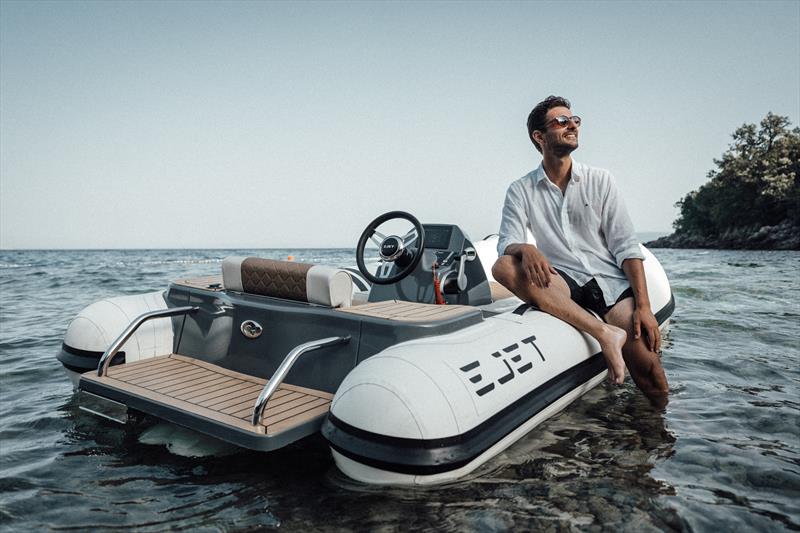
After years of research and development spent creating an electric jet tender that outperforms its combustion-dependent competitors, EJET has officially begun sales of its 4X yacht tender.
“From the very beginning, our objective was clear: to create a jet tender that could not only rival traditional petrol-powered competitors, but surpass them,” explains EJET CEO, Žiga Jarc. “We homed in on achieving faster performance, extended battery life, and I’m proud to say we have accomplished it. We have delivered a well-balanced vessel with exceptional performance capabilities, while adhering to rigorous safety standards.”
The EJET 4X itself is 13 (ish) ft long, built on the Slovenian shipyard’s optimized RIB hull. It’s powered by an electric motor capable of delivering a solid 60 kilowatts of sustained power and powering the 4X to a top speed of 35 knots (≈65 km/h). Impressive on its own, but doubly so when paired with EJET’s optional, and positively massive, 159 kWh battery, offering a range of up to 40 nautical miles (at lower speeds, of course).
A lot of that built-in capability, though, doesn’t come from a truck motor or some new battery tech. It comes from approaching the problems of a boat from the perspective of boatbuilding, instead of trying to build a “Tesla of the sea.”
EJET CEO Žiga Jarc explains the challenges the company faced in developing a high-performance jet tender, saying that, “When it comes to electric boating, most often, people turn to the automotive industry for inspiration. But we quickly realized that this approach comes with limitations. A boat, being on the water, presents a completely different challenge. The density of water is 830 times higher than that of air, which means it’s like constantly climbing uphill. This led to a host of problems that demanded a different approach and exploring uncharted options.”
To that end, EJET spent a significant amount of time optimizing the 4X’s hull for electric power, ultimately coming up with a design that provides comfortable motoring, even during turbulent conditions. It also features a hydraulic steering system designed in conjunction with the hull properties to make it easy for even novices to maneuver around a marina, as well as an actuator system that operates the reverse bucket system to enable ultra-quick stops, even from high speeds — all of which add up to some real benefits for yacht owners.
“Many owners want to be able to explore the waters where they are moored,” writes Jeff Butler at PlugBoats. “But there are increasing restrictions on fossil fuel motors in many eco-sensitive areas. The electric EJET allows them to access these untouched areas while preserving the natural environment. The other benefit the jet propulsion system brings is the shallow draft that makes beach landings and exploration of hard-to-reach areas much easier.”
Sounds good to me. Hey, EJET — any plans to fly out some journalists to take one for a spin? ::wink, wink::
Sources | Images: EJET, via New Atlas, Plugboat.
I don’t like paywalls. You don’t like paywalls. Who likes paywalls? Here at CleanTechnica, we implemented a limited paywall for a while, but it always felt wrong — and it was always tough to decide what we should put behind there. In theory, your most exclusive and best content goes behind a paywall. But then fewer people read it! We just don’t like paywalls, and so we’ve decided to ditch ours. Unfortunately, the media business is still a tough, cut-throat business with tiny margins. It’s a never-ending Olympic challenge to stay above water or even perhaps — gasp — grow. So …
Sign up for daily news updates from CleanTechnica on email. Or follow us on Google News!
Have a tip for CleanTechnica, want to advertise, or want to suggest a guest for our CleanTech Talk podcast? Contact us here.
Former Tesla Battery Expert Leading Lyten Into New Lithium-Sulfur Battery Era:
CleanTechnica uses affiliate links. See our policy here.






